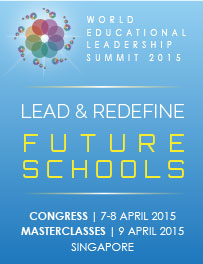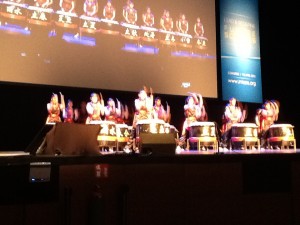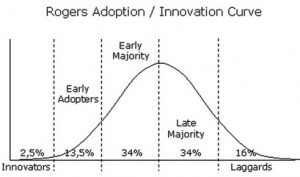I recently attended the World Educational Leadership Summit run by the International Association for Scholastic Excellence in Singapore. The conference focus was on leading and redefining schools. I was keen to see how the speakers’ thinking aligned, particularly in the Asian educational environment. I was surprised by how many Australians attended the conference and it was interesting to hear about the innovation occurring in international schools around the region.
Stephen Murgatroyd outlined the challenges for the future of schools, arguing that we are currently in what he neatly described as “the in-between time”. He mentioned Roger’s curve which is a nice visual example of laggards versus early adopters. He argued that “schools innovate, systems don’t”, and that “collaboration is the DNA of the innovation economy.”
Simon Breakspear outlined a blueprint for deeper learning in schools by looking at what works for innovative global leaders and organisations. He spoke about identifying the most high leverage learning problem in a school, and then pursuing rapid prototyping cycles, starting small, learning fast, and failing well. He reinforced that transformation can only occur at the speed of trust between the most innovative educators and the rest of their colleagues.
Describing an innovation-driven economy, Tony Wagner insisted that “Isolation is the enemy of improvement and innovation”, and that schools should be teaching the skills of collaborative problem-solving. He claimed that educators have a responsibility to help both parents and students understand the need for change, “Being a good exam-taker is no longer a guarantee of employment or success.” Tony also promoted Looking at Student Work protocols and using digital portfolios formatively.
Sugata Mitra described his Hole in the Wall project, Self-Organised Learning Environments, and the School in the Cloud project. He claimed that children in these environments can competently search for answers to big questions, far ahead of what is expected of them in their school curriculum. “A SOLE is bringing a PhD down to a 9-year old.” Teachers should understand that they are managers of chaotic systems, and this chaos enables learning. He also argued that schools should not be assessing individually, “Allowing the Internet into the examination hall will change the entire system.”
Pasi Sahlberg explained how Finland has succeeded in avoiding the global education reform movements prevalent in the USA, UK, and Australia. He spoke about the importance of encouraging failure in schools, “fail early and fail often.” The 13th of October is a national day to celebrate failure in Finland. Pasi stated that in the next ten years Finland is aiming to cut down instruction time by half. He explained the recently much heralded phenomenon-based teaching approach, which is essentially newly created curriculum space for schools to develop an integrated unit of study. Of most interest to me is that students will be involved in the planning and assessment of these new phenomenon-based units. Pasi also made the point that many high-performing systems speak two languages.
Yong Zhao spoke about how the knowledge and skills valued by schools today may not help children live a successful life in the future. There is currently a global youth unemployment problem – young, educated, unemployed. We have to assume there will be no jobs. Technology and globalisation are changing the value of knowledge and skills. Schools have lost the monopoly over knowledge and learning opportunities. A traditional assessment system tests what we teach, not what students have learned. Short-term instruction is affecting long-term outcomes. The pursuit of high test scores requires sacrifices. Cheating is the most effective way of passing the exam. Is what we are teaching important? Is what we measure important? “If you have no intrinsic motivation you get small cleverness, not big wisdom.” Everyone now needs a start-up mindset. Google is saying that if you want to be managed you are unemployable. Schools need to release their staff from Stockholm syndrome.
I also finally met the inspiring Jon Andrews, Executive Director of Teaching and Learning at St Paul’s College in Brisbane. Check out some of the things his school is doing in terms of self-determined learning and innovative leadership roles.
My takeaways:
What should I keep doing?
The emphasis we are placing on staff collaboration, the use of protocols, and building trust to become a true learning organisation has been strongly reinforced, as have PBL and Reggio-inspired pedagogies. The work of our Student ThinkTank was also reinforced.
What should I start doing?
I’m thinking about using the Question Formulation Technique at the start of a unit and incorporating the student questions into the unit planning. Sugata Mitra’s SOLE framework appears worthy of investigation as a framework for teaching with technology. I am going to experiment with using Google Drive as a digital portfolio and I need to model this by putting my teaching units online. I’m wondering if I can steal the 13th of October as a day to celebrate failure at my school? I need to explain to parents and students why being a good exam-taker is no longer a path to success and employment. Also, it is time for me to collate my resources on group learning into a presentation.
What should I stop doing?
Tony Wagner spoke about taking staff to another school to learn from others. Years ago I took three Heads of Department to another school to explore learning spaces and innovative approaches. We had lunch in a restaurant before returning to school and those HODs have since described it as one of their most powerful professional learning moments. I’m wondering if I should do more of this and release HoDs from their presently mandated professional learning requirements.


